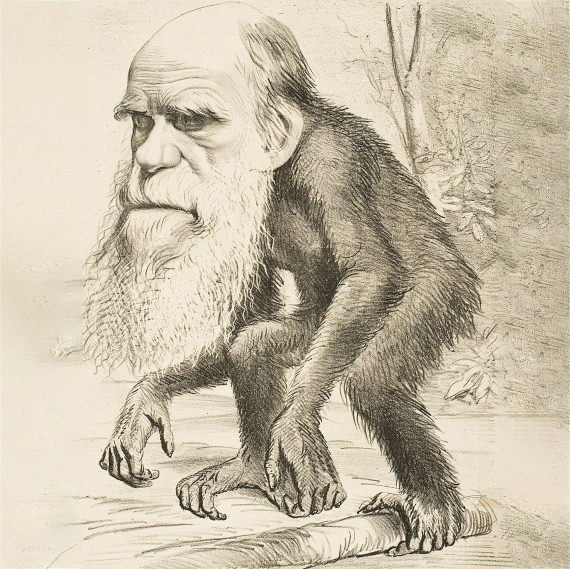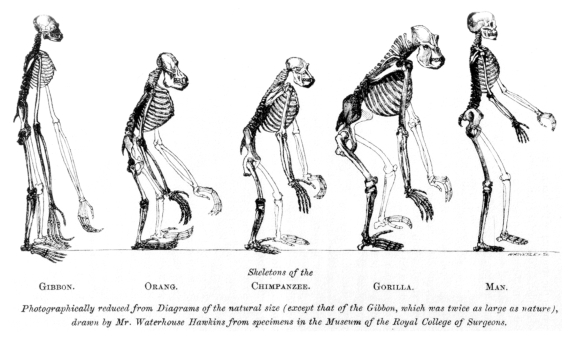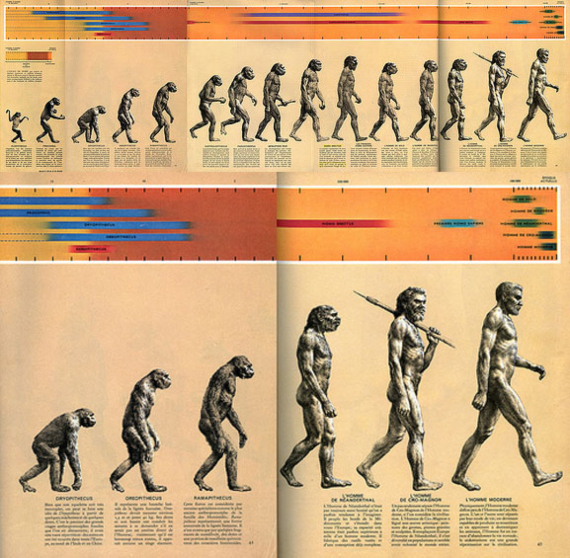If we ask someone what Charles Darwin’s essential contribution to science was, they are likely to respond that he was the English naturalist who discovered that humans are descended from monkeys. In 1871, the second of Darwin’s best-known works, The Descent of Man, was published, in which he applied to human evolution the principles previously described in On the Origin of Species. On March 22nd of that year, a famous cartoon appeared, showing the head of the scientist himself on the body of an ape. It was followed by many others, but one year earlier in Spain, in 1870, the label of Anís del Mono (Monkey Anís), a liquor still consumed today, first appeared, portraying an ape with a human head—Darwin himself?—clutching a scroll of paper on which it reads: “It is the best. Science said so and I don’t lie.”

In fact, not only did Darwin never propose that humans are descended from monkeys, but the very idea is erroneous. For some reason, 150 years later, the work of the father of the theory of evolution has remained one of the most misunderstood in the history of science.
It suffices to mention other ideas that are popularly associated with his work: Darwin’s famous finches did not inspire the theory developed in On The Origin of Species; in fact, they are not even mentioned in it. Only in later books did the naturalist analyse the birds of the Galapagos in detail, but more so the mockingbirds than the finches. Moreover, many will be surprised to learn that the noun “evolution” is not mentioned even once in the first editions of On the Origin of Species—Darwin spoke simply of “variation.” At the very end of the work, the word with which the book closes is the verb “to evolve,” it’s only appearance.
The idea of kinship between humans and apes
But if the foundational work of his theory caused an upheaval in science and in human thought in general, with The Descent of Man Darwin himself became the centre of debate and criticism. And this despite the fact that the proposal of evolutionary relationships between humans and other primates was not a novelty at the time. A more or less rudimentary notion of the transmutation of some species into others—evolution—had existed at least since the Greek philosopher Anaximander, more than 500 years before Christ, and throughout the following centuries as a result of the observation of fossils. But in Darwin’s century as well, the idea of kinship between humans and apes was already being discussed. Others had made this connection before the naturalist, with Thomas Henry Huxley‘s Evidence as to Man’s Place in Nature (1863) being the first scientific book that dealt in depth with the problem of human evolution.
Huxley’s work was eight years ahead of Darwin’s, although in it the author did no more than apply to human beings the principles discovered earlier by his colleague, extending the idea that closed On The Origin of Species, according to which multiple forms of life had appeared from one or a few. Its implication in relation to humans, which in his previous volume Darwin had left aside with the suggestion that “light will be thrown on the origin of man and his history,” was nevertheless already more than evident.

Thus, at the time, The Descent of Man was considered a late intervention in this field, when the problem of human evolution was already the subject of wide discussion. But both Huxley’s and Darwin’s works made it clear what the concept was: humans and other primates descended from a “common progenitor,” from “some lower form,” not the former from the latter. The confusion has reached the present day, leading many people to believe that apes such as chimpanzees, orangutans or gorillas are frustrated human designs, like species that got stuck halfway through their evolution—The Planet of the Apes—and did not progress any further. This is a wholly mistaken view, since both they and we have travelled evolutionary paths of the same length, albeit divergent. One study found that there are in fact more genes that have undergone positive natural selection in the chimpanzee genome than in the human one, so technically it could be said that chimps have actually evolved more than us.
The famous March of Progress
This misconception of seeing all the other primates as humans in the construction phase has been compounded by an unfortunate and oft-reproduced drawing that shows different hominins walking in line behind the human being. The illustration, called The March of Progress or The Road to Homo sapiens, was originally created in 1965 for Life Nature Library by the artist Rudolph Zallinger, although it had its precursors: Huxley’s book included a drawing of the skeletons of several primates, but with no other purpose than comparative, and in 1889, Mark Twain’s novel A Yankee in King Arthur’s Court published in one of its editions a drawing of animals gradually transformed into humans, with the title “Evolution.”
In reality, and although The Descent of Man has endured as the book in which Darwin established the link between humans and other primates, its purpose was not to provide an idea already accepted by science at the time. Instead, the naturalist analysed this evolutionary kinship through the prism of sexual selection, a hypothesis that he had not been able to fully develop in On The Origin of Species, and according to which certain variations were not transmitted to offspring because they offered an advantage for survival, but rather for reproduction. The classic Darwinian example is the feathers of the male peacock, which attract females the larger and more conspicuous they are. In the case of humans, Darwin proposed numerous possible examples of sexual selection, such as physical beauty, the beard or the lack of male body hair as compared to monkeys.

Darwin’s work also explored the evolutionary aspects of psychology, morality, religion, ethnicity and civilised society itself, aspects that other authors of his time had not dealt with. Some of his approaches are now seen as seriously flawed, lapsing into racism and sexism, something that Antoinette Brown Blackwell, the first Protestant minister ordained in the USA, criticised him for in her day. But if nowadays his errors are well known, the least that the venerable naturalist deserves is for his great successes to be equally recognised.
Comments on this publication